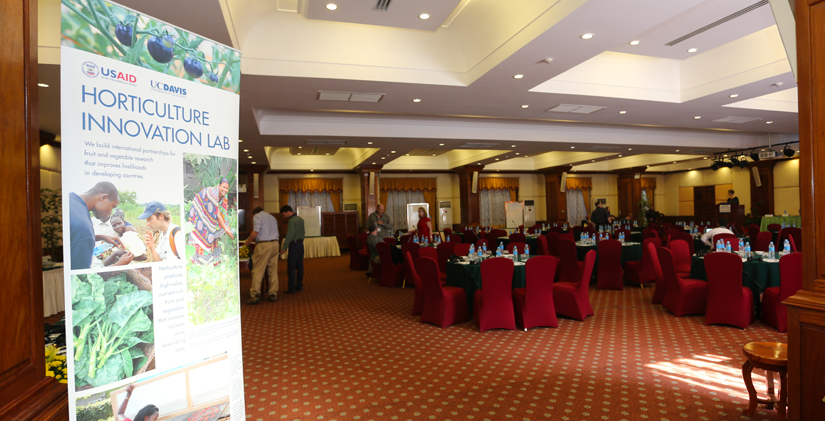
Another year, another annual meeting: Horticulture Innovation Lab partners gathered this time in Cambodia to share achievements, exchange ideas, and scheme about their next steps in advancing horticultural science and helping smallholder farmers in developing countries.
Exchanging horticultural ideas at lightning speed
Nearly 100 scientists, development practitioners, and other horticultural partners gathered for a Regional Horticulture Conference on the first day of the meeting.
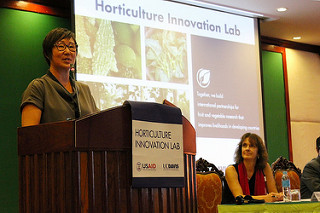
Elizabeth Mitcham of the Horticulture Innovation Lab, Men Sarom of the Royal University of Agriculture, Sang Lee of USAID/Cambodia, and John Bowman of USAID’s Bureau for Food Security provided welcoming remarks to set the scene for the day and its priorities.
Lee highlighted the accomplishments of Feed the Future activities in Cambodia, including USAID’s continued investment in horticulture to increase incomes and nutrition through fruits and vegetables.
“It is estimated that 70 percent of vegetables are imported from neighboring countries,” she said. “Even if we can reduce that 70 percent marginally, I think that can make a big difference.”

Much of the conference day was split into 5-minute lightning talks, with a total of 15 speakers sharing just the highlights of their recent horticultural work. After one hour of presentations, the speakers and participants circulated for follow-up questions and in-depth discussions sparked by the brief talks. (See slides from the lightning talks on our website, and watch for 5-minute video features of these talks in future blog posts.)
The day concluded with a lively Horticulture Expo, with hands-on demonstrations and technology information from iDE Cambodia, the World Vegetable Center (AVRDC), Kasetsart University, the USAID-funded Cambodia HARVEST project, the ECHO Asia Impact Center, and the Horticulture Innovation Lab.
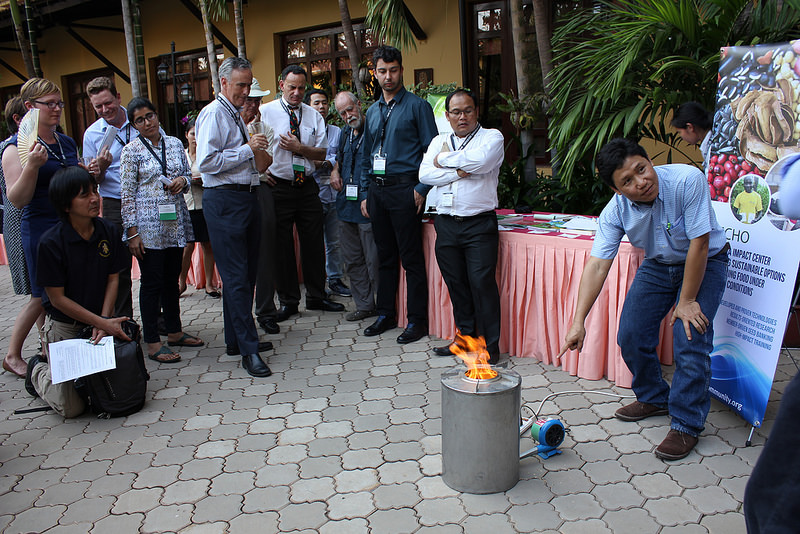
Visiting horticultural field sites
The second day of the Horticulture Innovation Lab’s annual meeting sent participants in small groups out to farm fields and project sites.
At the Cambodia HARVEST project site, Dennis Lesnick and Symantha Holben of Fintrac toured visitors through three different plots, where farmers were growing vegetables commercially using tools such as drip irrigation, plastic row covers, and trellises. This USAID-funded project focused on agriculture as a business for households with larger land holdings to introduce commercial farming technology.
Two other stops were hosted by the Beng Mealea Vegetables farmers cooperative, a group that is working on the Horticulture Innovation Lab’s “Promoting conservation agriculture for vegetable growers” project. The group has developed a marketing motto of “Grown Right, Handled Right, Community Right” to help them explain their values to potential customers, as they are selling their vegetables directly to consumers through neighborhood deliveries.
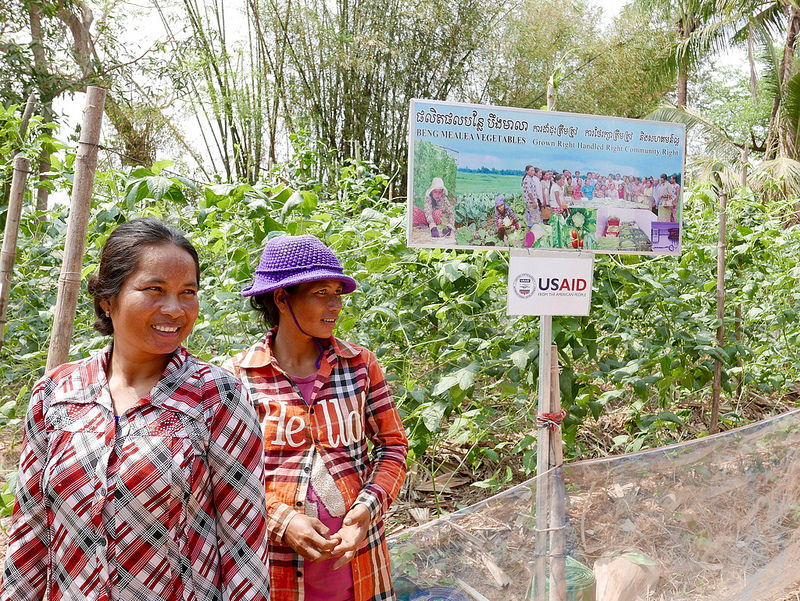
Accordingly, the first stop with this group focused on “Grown Right” at farmer Moa Kong’s vegetable fields. She and fellow women farmers demonstrated the conservation agriculture practices they have adopted to grow vegetables, including planting seedlings for 5-6 vegetable crops per year, not tilling new rows, using mulch to control weeds, and using drip irrigation.
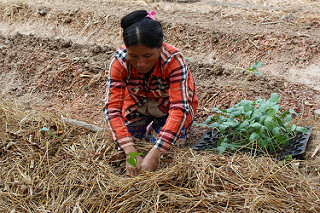
Farmer Dek Huon showed visitors what traditional hoeing would look like when planting a new crop, versus the task of planting seedlings in pre-formed beds. Another farmer, Tho Roam, demonstrated how she would carry water to fields that are not installed with drip irrigation. Researchers on this project estimate that to grow vegetables on 100 square meters with traditional hand watering requires hauling about 1,300 pounds of water per day during the dry season.
Manuel Reyes, professor at North Carolina Agricultural and Technical State University, leads this Horticulture Innovation Lab project and spoke to participants about how conservation agriculture reduces drudgery while improving soil for vegetable farmers. Agricultural technician Ren Ry and Lyda Hok, an instructor at the Royal University of Agriculture, also provided background and translation for conversations between the farmers and international visitors.
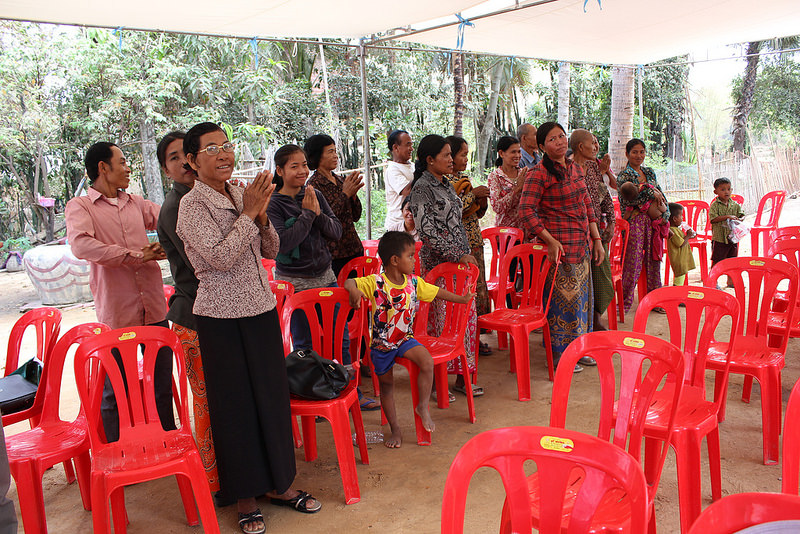
The next stop for this project covered both “Handled Right” and “Community Right” aspects of the project. Visitors explored the simple packinghouse set up for the farmers cooperative, with a sorting station, washing station, cooling station and cool room for storage. Borarin Buntong of the Royal University of Agriculture and Jun Acedo of AVRDC provided background information and information about how to uses these tools to improve produce quality and reduce losses.
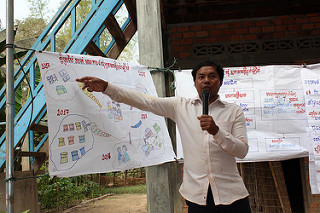
The “Community Right” station was a group meeting of members of the farmers cooperative, with translation and background provided by Yun Sinang of Agricultural Development Denmark Asia (ADDA) and the projects’ marketing technician Sel Rechaney. Phong Suret, leader and board director for the cooperative, provided an overview of how the group works and its plans for the future. Other members of the supervisory committee also shared their insights and roles with the international visitors.
Getting work done
A much smaller group continued to meet on Wednesday for a workday, where Horticulture Innovation Lab researchers were provided updates on administrative topics and programmatic guidance.
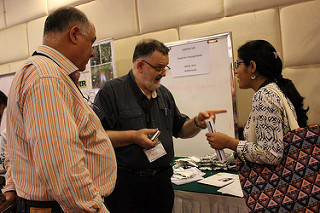
John Bowman of USAID provided the group with an update on Feed the Future progress and future directions for the agency. One highlight of the day was a gender workshop with presentations from Carolyn Sachs, Janelle Larson and Leif Jensen of Penn State and thorough group discussions. Kate Scow and Mark Bell of UC Davis led the group in a fill-in-the-blanks activity to write impact statements, and David Hansen of the University of Minnesota shared inspiring photos and photography tips. UC Davis staff members of the Horticulture Innovation Lab also led discussions on data management plans, environmental mitigation and monitoring, the program’s website, and social media for extension.
On Thursday, members of the Horticulture Innovation Lab’s International Advisory Board had a productive meeting to review the program’s progress and provide advice. New members Guillermo Alvarado-Downing from Honduras and Jan Hopmans of UC Davis joined the group meeting for the first time.
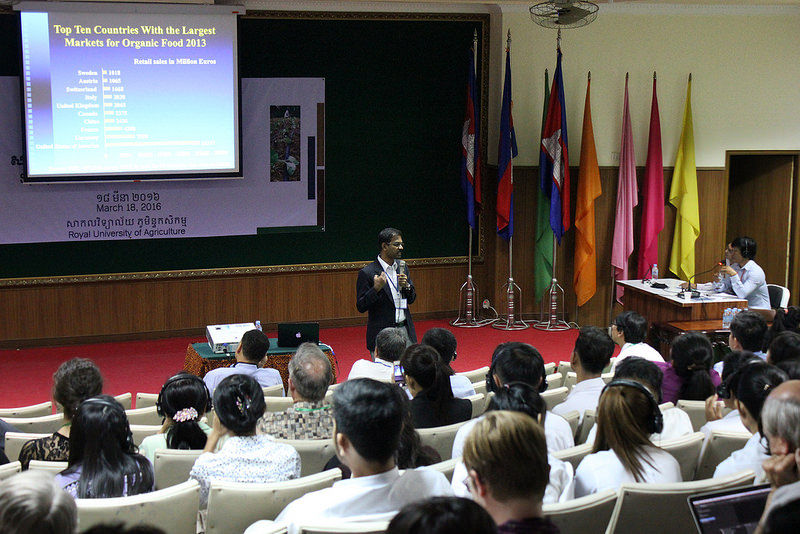
Ramu Govindasamy of Rutgers, the State University of New Jersey, speaking about organic produce markets around the world, at the Symposium on Horticultural Science at Cambodia’s Royal University of Agriculture.
Sharing horticultural science with local university
A small group of speakers from the Horticulture Innovation Lab gathered for one final event of the 2016 annual meeting, but in Cambodia’s capital city, Phnom Penh. The Horticulture Innovation Lab partnered with Cambodia’s Royal University of Agriculture to host the “Symposium on Horticultural Science” for about 175 participants.
The university rector spoke at the day-long event, and 11 experts gave technical presentations on an array of horticultural topics, including soil biodiversity, pest management, food safety, postharvest practices, and improving extension. Students and other event participants also had a chance to present posters on horticultural topics.
See highlights from this event: Symposium highlights from Cambodia’s premier agricultural university
More:
- Read more blog posts about the 2016 annual meeting:
- Photos from 2016 annual meeting events in Cambodia on Flickr
- Presentations from the 2016 annual meeting
- Annual Meeting program (PDF)
